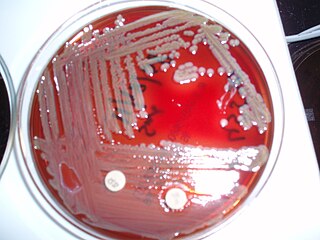Chrysiogenaceae is a bacterial family.
The Thermoprotei is a class of the Crenarchaeota.

Archaeoglobaceae are a family of the Archaeoglobales. All known genera within the Archaeoglobaceae are hyperthermophilic and can be found near undersea hydrothermal vents. Archaeoglobaceae are the only family in the order Archaeoglobales, which is the only order in the class Archaeoglobi.
In taxonomy, the Methanopyri are a class of the Euryarchaeota.
In taxonomy, the Thermoplasmata are a class of the Euryarchaeota.

In taxonomy, the Thermococci are a class of microbes within the Euryarchaeota.

In the taxonomy of microorganisms, the Methanomicrobia are a class of the Euryarchaeota.

Methanococci is a class of methanogenic archaea in the phylum Euryarchaeota. They can be mesophilic, thermophilic or hyperthermophilic.

The Desulfurococcales are an order of the Thermoprotei, part of the kingdom Archaea. The order encompasses a number of genera which are all thermophilic, autotrophs which utilise chemical energy, typically by reducing sulfur compounds using hydrogen.
In taxonomy, the Methanopyrales are an order of microbes within the class methanopyri.

In taxonomy, the Methanosarcinales are an order of the Methanomicrobia.
In taxonomy, the Methanosaetaceae are a family of microbes within the order Methanosarcinales. All species within this family use acetate as their sole source of energy.

Bacteroidales is an order of bacteria. Notably it includes the genera Prevotella and Bacteroides, which are commonly found in the human gut microbiota.

The class Flavobacteriia is composed of a single order of environmental bacteria. According to Bernardet et al., Flavobacteriia are Gram-negative aerobic rods, 2–5 μm long, 0.3–0.5 μm wide, with rounded or tapered ends that are motile by gliding, yellow colonies on agar, decompose several polysaccharides but not cellulose, G+C contents of 32–37%, and are widely distributed in soil and fresh and seawater habitats. In particular, Flavobacteriia are prominent members of marine biofilms. The type species Flavobacterium aquatile was isolated from a well in Kent, England.

The order Flavobacteriales comprises several families of environmental bacteria.
The Sphingobacteriales is an order of environmental bacteria.
Methanocaldococcus formerly known as Methanococcus is a genus of coccoid methanogen archaea. They are all mesophiles, except the thermophilic M. thermolithotrophicus and the hyperthermophilic M. jannaschii. The latter was discovered at the base of a “white smoker” chimney at 21°N on the East Pacific Rise and it was the first archaean genome to be completely sequenced, revealing many novel and eukaryote-like elements.
In taxonomy, Methanotorris is a genus of the Methanocaldococcaceae. The organisms in this genus differ from those of Methanothermococcus in that they are hyperthermophiles and from those of Methanocaldococcus in that they have no flagella, are not motile, and do not require selenium to grow. These microbes have not been shown to cause any illnesses.
Mycoplasmatota is a phylum of bacteria that contains the class Mollicutes. The phylum was originally named "Tenericutes". Notable genera include Mycoplasma, Spiroplasma, Ureaplasma, and Phytoplasma.
Bergey's Manual of Systematic Bacteriology is the main resource for determining the identity of prokaryotic organisms, emphasizing bacterial species, using every characterizing aspect.






